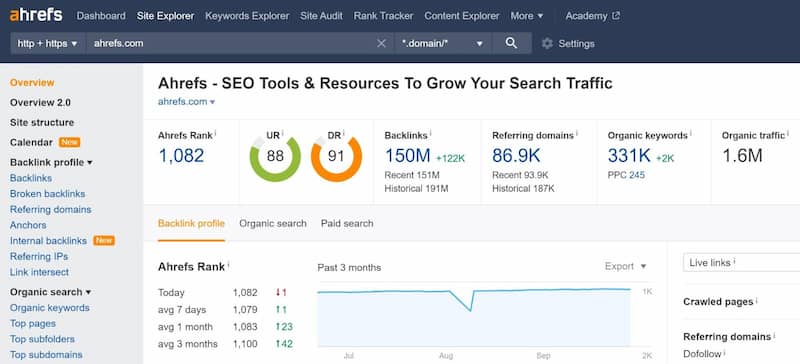
Every effective SEO plan must include link-building initiatives as a fundamental component. Your website needs high-quality links from high-quality sources if you want to establish authority and gain the trust of search engines. Since link equity plays a significant role in its value, links continue to be the internet’s primary currency. What, however, is link equity and makes some links more advantageous than others?
The fundamentals of link equity are covered in this article, along with its history and current methodology of calculation. These link equity concepts should be leveraged for a scalable content development program to design a content production process and an effective outreach campaign that produces effective links.
Link equity: what is it?
The value that a link passes from one website to another is referred to as link equity, and is sometimes referred to as “link authority” or “link juice”. It is determined through a number of factors which include:
● The quality of the website being linked to
● The link’s placement
● How relevant is the target of the link by comparison to its source
It’s essential to understand how authority and equity transfer across websites while establishing links and promoting blogs for traffic. Optimize your links for each of the 11 link equity variables in the following to boost your backlink profile and elevate the placement of your website in search results.
PageRank algorithm: why is it important?
In 1998, the initial PageRank algorithm was designed and named after the co-founder of Google, Larry Page, a name that also works with the term “web page.” Two primary factors drive this iterative approach that determines the reliability value of a webpage. They are:
● Determining how important a page is based on how many other pages link to it
● Much like water flows downstream in rivers or through pipes, a network link of pages moves link equity through a network of pages
Using a scoring scale of 0 to 10, PageRank assigns a score to each webpage. At first, this data was displayed in the Google Toolbar for everyone to see, though, after 2012, the underlying data was no longer updated openly. In 2016, the metric’s public availability was completely discontinued. PageRank is still used by Google, although it is now only one of several ranking variables.
Google has frequently updated its link-valuation algorithm to be more complex to counter the predominance of link spamming in blog comments, directories, and link farms. Unfortunately, this also made the value of a webpage harder to determine.
Link equity has changed from being a straightforward exercise in link counting to a far more complex system that takes into account a variety of elements as part of SEO strategy. This means that the quantity of links has been rendered far less important than its quality.
How google calculates link equity (11 methods)
Google and other search engines consider several link equity indicators to assess a link’s quality. The value that a link transfers to another website are known to be influenced by the following 11 link equity criteria.
Internal versus external links
More link equity is offered by external links from other websites than by internal links from your own. While internal links are seen as a navigational tool to manuever the website’s content, external ones promote authority and trust.
However, internal linking techniques are still essential for enhancing value flow, as it assures that link equity is distributed throughout your whole website by carefully connecting to relevant pages. However, developing organic visibility is far more challenging in the absence of any outside external validation.
Interior pages versus home page
Home pages generally enjoy a lion’s share of link equity since internet users generally link there first, but earning links to interior pages is quite robust in garnering linking benefits too. The trick to getting the most equity from an inbound link is, instead of linking to your home page, to send visitors to a page deep in your website. Linking to home pages can become overly “top-heavy,” so linking to sub-pages is a way to avoid that effect from manifesting.

Link Authority
Links from websites with a high domain authority often convey more link equity than links from websites where authority is low. Likewise, links from websites with high URL authority are worth more. While URL authority measures link strength at the level of a single webpage, domain authority measures link strength across the whole website. These ratings, which range from 0 to 100, help to determine how well a website will perform in SEO rankings.
Domain and URL ratings are calculated using the following factors:
● How old the domain is
● Size of the website
● Quality of the content
● Profile of backlinks
You may utilize Ahrefs, Moz, Semrush, and other SEO software providers that keep an eye on Google changes to determine the authority of linked websites. But keep in mind that because they are merely a substitute for the internal estimation employed by search engines, each tool will differ in its calculation methods.
Link relevancy
Each website has a different weight influence, and that factor is certainly considered by search engines. The connecting content should be relevant to those on your site in order to be considered fully credible.
An SEO business, for instance, should receive link equity from a link from a marketing website, though a financial services company isn’t likely to benefit from links to destination and travel sites because the latter lacks relevance in terms of making any meaningful contributions to the financial sector.
Link diversity
Gaining a link from a brand-new domain is more advantageous than getting one from a website previously linked t because it helps to drive a growing link network increasing the link equity of your website.
To that end, it is generally beneficial to track both the number of backlinks you create and the number of distinctive referring domains linking to your target website. Luckily, there are several AI SEO tools available to assist with this effort. Link quality will continue to outweigh link quantity, of course, but with all else being equal, diversification and growth of our link network are pivotal.
Link anchor text
A clickable phrase used to link one website to another is known as anchor text. According to Google reps, anchor text does provide useful context when link building, despite being a hotly contested topic in the SEO industry.
Ahrefs studied almost 400,000 web pages to determine the effect of anchor text on keyword ranking. Though their entire blog post is available for those seeking more context in their study’s findings, the analysis’s conclusion revealed a modest, though the positive relationship between search engine rankings and exact anchor text matches.
Combining this data with Google’s recommendations suggests that employing descriptive anchor text could have some advantages. Manipulation and excessive attempts at over-optimization for exact keyword matches are unadvisable, however. In fact, it can have a negative impact by raising red flags about your attempts at using link-building.
No-follow links versus follow links
Links marked with the rel=”NoFollow” tag in the HTML are known as no-follow links. Search engines are instructed not to send equity over the link using this attribute. Therefore, no-follow links do not benefit a website’s SEO.
In contrast, “follow” links do not have this tag and so they carry link equity, which does have a positive impact on SEO. Having said that, Google does not only rely on the lack of the “no-follow” tag to determine the order of web pages in search results. Therefore, a link may not always provide SEO benefits even if it is a “follow” link. Additionally, even if a link is no-follow, it can still be useful for traffic and brand exposure in addition to SEO.
Crawlable links
A robots.txt file can be used to instruct search engines not to crawl and index particular sites. When this happens, all of the links on a page are disregarded and are considered to be dead, and those do not offer your website any link equity.
Use a link checker like Dead Link Checker or Sitechecker.pro to see if a link is active and crawlable. With the use of these tools, you may find any possible link equity from “dead” links and take the necessary steps to retrieve value from them again. If the links on your own website are not indexed, building a sitemap and getting rid of any “NoIndex” tags will help you rank higher.
Link placement
How much link equity is conveyed passed can also depend on where a link is located on a page. A link in a page’s footer or sidebar, for example, is typically of lesser value than a link in the main body of the text. It is harder for users to notice these links, and that makes them less likely to be clicked on. The link capacity to pass link equity is likely to be limited by this decreased link interaction.
Including a link to your target website early in an article or blog post might be beneficial as well for the same reason. Users are much more likely to see the top of the page than the bottom, so links located earlier in the content are generally more valuable than links further down or in an author profile.
HTTPS status
Google claims that all 300 redirects, including those from HTTP to HTTPS, keep their link equity, but other search engines might not subscribe to the same methodology. It is additionally unclear if redirecting irrelevant links from an acquired domain to your home page actually increases your link equity.
Link quantity
The number of links from a domain and on a page is both very important factors in link equity. The links on a page essentially share the entire amount of “link juice” from that page. Due to this, link-building strategies like link farms, which involve adding hundreds or thousands of links to a webpage, are ineffective.
Surprisingly, the same is true for social networking sites that have a lot of authority. The link equity from a single link, even though it is technically do-follow, is virtually nothing because these domains have billions of outbound connections.
Closing thoughts
Measuring link equity is a complicated aspect of SEO, especially due to the opaque nature of how it is calculated. However, by being aware of elements that increase impact link equity, more solid decisions can be made in your link-building and link-positioning efforts.
It’s also imperative to consider how link equity has changed over time, from the early PageRank era to the present methodology. Websites should certainly concentrate on people-first content based on the evolution of Google updates, including its most recent changes.
Algorithms used by search engines will be perpetually refined to benefit users searching for information. It’s generally better to concentrate on developing a link profile that will stand the test of time rather than taking advantage of short-term vulnerabilities. Your website will enhance its link equity and sustainability by producing value-driven content and linking organically.
FAQ about link building
How is link equity increased?
Create an outreach strategy that focuses on authoritative websites in your sector that haven’t previously linked to yours to enhance link equity. Utilize internal connections as well to transfer equity to weaker pages from your stronger ones.
How is “link juice” measured?
Although ‘link juice’ cannot be directly measured, a number of SEO software applications can calculate page and domain authority. Numerous indicators are available from Semrush, Ahrefs, Moz, and other SEO tools that may help you figure out how much link equity exists on every page.
How can link equity be preserved?
Set up redirects when pages are deleted from your website and keep an eye on your backlinks for any invalid links to prevent link equity loss. Avoid duplicate material as well, which might arise from link canonicalization problems.
What exactly is link velocity?
The rate at which a website adds new backlinks is known as its link velocity. An unusually high link velocity may be a symptom of link spamming and manipulation, which could result in penalties from the Google algorithm. Focus on constructing high-quality links steadily over time to avoid this. You should be safe so long as your linking strategies are ethical and organic.
What is link baiting?
Generating content material with the specific purpose of soliciting inbound links to a particular website is known as “link baiting.” The skyscraper approach, which calls for producing significantly higher-quality content than anything else on the web, is advised by several SEO experts. By doing so, you’ll compel other websites to connect to your material naturally, and you might even be able to “steal” links from less-effective web pages.






